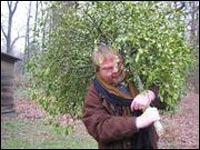From a bird’s eye view! – Are mistletoes indicators for soil pollution?

Prof. Dr. Dr. Ewald Schnug with mistletoe. Photo: FAL-PB
A Christian legend has it that the mistletoe was damned by God to a parasite’s life, because Christ’s cross was made out of its wood. It was hold sacred by ancient Teutons as it symbolised the continuity of life and fertility because of living between heaven and earth, and staying green even in winter. From this belief the tradition of kissing under the mistletoe at Christmas still dates back. Druids (and who does not know Miraculix in the world-famous comic series “Asterix”!?) cut them with golden sickles at top-secret places at the turn of the year and from them they brewed all kinds of healing and magic drinks.
The spots, where the mistletoes (Latin: Viscum album, i.e. “white slime” and points to the berries’ sticky features) grow, are not secret anymore. They occur massively in northern Germany. The mistletoes may gain considerable dimensions and are an enormous burden for the host due to their sheer weight and demand for nutrients. So, a mistletoe may easily weigh 15 kg and have a diameter of 1.5-m (see picture 1).
For the propagation of the mistletoes many factors are important such as the type of host tree, birds’ species, microclimate, and last but not least the individual resistance of the host. Scientists of the Institute of Plant Nutrition and Soil Science of the Federal Agricultural Research Centre (FAL) in Braunschweig, Germany, are investigating, how soil pollution with heavy metals might be related to the predisposition of the trees and vice versa the existence of mistletoes indicates such stress. By means of a Geographical Information Systems (GIS) the scientists overlay geographical and soil information with the appearance of mistletoes. Aerial images taken at low altitude are collected either from miniature planes or from a remote-controlled “aerosonde”, better known to the public as “drones” from war reports during the past years. The FAL-scientists work closely together with the colleagues of the German Centre for Aerospace (DLR) in Braunschweig, which use a so-called Micro-Airlab for taking images.
For the differentiation between host tree and mistletoe the scientists employ colour infrared photography (CIR). On such pictures intact green leaf tissues appear intensively red revealing a distinct contrast between mistletoes and trees as well as surrounding patterns (photo 2) which makes them easy to count.
Contacts: Prof. Dr. Dr. Ewald Schnug, Federal Agricultural Research Centre (FAL), Institute of Plant Nutrition and Soil Science, Bundesallee 50, D-38116 Braunschweig, phone +49 531 596 2101, E-mail: pb@fal.de
Media Contact
All latest news from the category: Life Sciences and Chemistry
Articles and reports from the Life Sciences and chemistry area deal with applied and basic research into modern biology, chemistry and human medicine.
Valuable information can be found on a range of life sciences fields including bacteriology, biochemistry, bionics, bioinformatics, biophysics, biotechnology, genetics, geobotany, human biology, marine biology, microbiology, molecular biology, cellular biology, zoology, bioinorganic chemistry, microchemistry and environmental chemistry.
Newest articles

High-energy-density aqueous battery based on halogen multi-electron transfer
Traditional non-aqueous lithium-ion batteries have a high energy density, but their safety is compromised due to the flammable organic electrolytes they utilize. Aqueous batteries use water as the solvent for…

First-ever combined heart pump and pig kidney transplant
…gives new hope to patient with terminal illness. Surgeons at NYU Langone Health performed the first-ever combined mechanical heart pump and gene-edited pig kidney transplant surgery in a 54-year-old woman…

Biophysics: Testing how well biomarkers work
LMU researchers have developed a method to determine how reliably target proteins can be labeled using super-resolution fluorescence microscopy. Modern microscopy techniques make it possible to examine the inner workings…





















